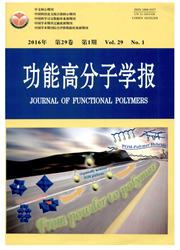

 中文摘要:
中文摘要:
在这份报纸,与悬挂的羧基的组一起的脂肪族的聚酯 functionalized 经由几步被综合。第一,代替了周期的酉同类, 2-(benzyloxycarbonyl 甲基) cyclopentanone (BCP ) 与 benzyl-2-bromoacetate 通过 enamine 的反应被准备,并且随后变换成相关 functionalized -valerolactone 衍生物, 5-(benzyloxy carbonylmethyl )-- 由 Baeyer-Villiger 氧化的 valerolactone (BVL ) 。第二,有 -caprolactone 的 BVL 的戒指洞聚合大批被执行把亚锡的 octoate 用作催化剂 poly 生产(忍受保护本甲基的 carboxyl 的 -caprolactone-co--valerolactone) 功能的组[P (CL-co-BVL )] 。最后, P (CL-co-BVL ) 的保护本甲基的组被把 Pd/C 用作催化剂 poly 获得的 H2 有效地移开(忍受悬挂的羧基的酸的 -caprolactone-co--valerolactone)[P (CL-co-CVL )] 。结构和聚合物的性质被原子磁性的回声(NMR ) 学习了, Fourier 红外线的光谱学(英尺红外) 和微分扫描热量测定(DSC ) 等等。NMR 和英尺红外结果证实了聚合物结构,并且 13C NMR 系列清楚地解释了 -caprolactone 和 5-(benzyloxycarbonylmethyl ) 的顺序 -- 在共聚物的 valerolactone。当保护本甲基的组被移开时,生羧基的组的脂肪族的聚酯被获得。而且,聚合物的 hydrophilicity 被改进。因此, poly (-caprolactone-co--valerolactone) 可能在生物医学的地里有大潜力。
 英文摘要:
英文摘要:
In this paper, aliphatic polyesters functionalized with pendant carboxylic groups were synthesized via several steps. Firstly, substituted cyclic ketone, 2-(benzyloxycarbonyl methyl)cyclopentanone (BCP) was prepared through the reaction of enamine with benzyl-2-bromoacetate, and subsequently converted into the relevant functionalized 6-valerolactone derivative, 5-(benzyloxy carbonylmethyl)-δ-valerolaetone (BVL) by the Baeyer-Villiger oxidation. Secondly, the ring-opening polymerization of BVL with ε-caprolactone was carried out in bulk using stannous octoate as the catalyst to produce poly(ε-caprolactone-co-δ-valerolactone) bearing the benzyl-protected carboxyl functional groups [P(CL-co-BVL)]. Finally, the benzyl-protecting groups of P(CL-co-BVL) were effectively removed by H2 using Pd/C as the catalyst to obtain poly(ε-caprolactone-co-δ-valerolactone) bearing pendant carboxylic acids [P(CL-co-CVL)]. The structure and the properties of the polymer have been studied by Nuclear Magnetic Resonance (NMR), Fourier Infrared Spectroscopy (FT-IR) and Differential Scan Calorimetry (DSC) etc. The NMR and FT-IR results confirmed the polymer structure, and the 13C NMR spectra have clearly interpreted the sequence of ε-caprolactone and 5-(benzyloxycarbonylmethyl)-δ-valerolactone in the copolymer. When the benzyl-protecting groups were removed, the aliphatic polyesters bearing carboxylic groups were obtained. Moreover, the hydrophilicity of the polymer was improved. Thus, poly(ε-caprolactone-co-δ-valerolactone) might have great potential in biomedical fields.
 同期刊论文项目
同期刊论文项目
 同项目期刊论文
同项目期刊论文
 Synthesis and Characterization of Poly(epsilon-caprolactone-co-delta-valerolactone) with Pendant Car
Synthesis and Characterization of Poly(epsilon-caprolactone-co-delta-valerolactone) with Pendant Car Synthesis and solution properties of pH responsive methoxy poly(ethylene glycol)-b-poly(gamma-amino-
Synthesis and solution properties of pH responsive methoxy poly(ethylene glycol)-b-poly(gamma-amino- Synthesis and self-assembly of pH-responsive amphiphilic poly(epsilon-caprolactone)-block-poly(acryl
Synthesis and self-assembly of pH-responsive amphiphilic poly(epsilon-caprolactone)-block-poly(acryl Surface properties of amino-functionalized poly(-caprolactone) membranes and the improvement of huma
Surface properties of amino-functionalized poly(-caprolactone) membranes and the improvement of huma Dual-response nanocarrier based on graft copolymers with hydrazone bond linkages for improved drug d
Dual-response nanocarrier based on graft copolymers with hydrazone bond linkages for improved drug d 期刊信息
期刊信息
